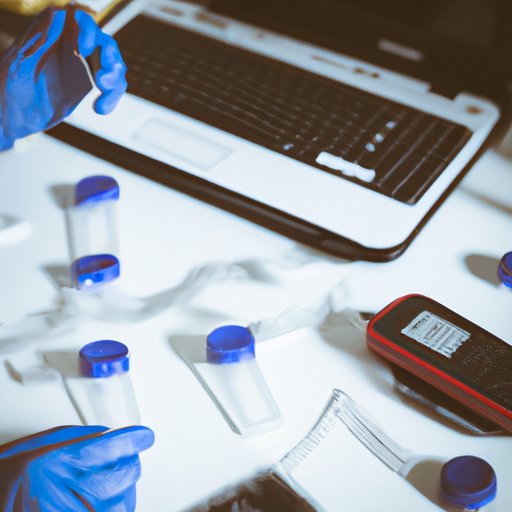Introduction
Forensic science is an interdisciplinary field that uses scientific methods to analyze evidence and help solve criminal cases. It has become an essential tool for law enforcement agencies around the world, helping to identify suspects, link perpetrators to crimes, and provide crucial information in court proceedings. But what exactly is forensic science, and how does it work? This article aims to answer these questions by exploring the different fields and techniques of forensic science, examining the role of evidence in criminal investigations, taking a look at the history and evolution of the field, and discussing potential future applications.

Exploring the Different Fields and Techniques of Forensic Science
Forensic science is composed of several specialized fields, each of which utilizes different techniques to analyze evidence. Crime scene investigation is one of the most important elements of forensic science. It involves collecting and preserving evidence from the crime scene, such as fingerprints, hair samples, and bodily fluids. Toxicology is another important field, which focuses on identifying and analyzing drugs, poisons, and other toxins present in the body. DNA analysis is also employed in many cases, allowing investigators to compare genetic material found at the crime scene with that of a suspect or victim.
Digital forensics is another important field of forensic science. It involves recovering, analyzing, and presenting digital evidence from computers, mobile phones, and other digital devices. Firearm and toolmark examination is used to identify and compare bullets, cartridge cases, and other toolmarks left behind at the crime scene. Trace evidence examination focuses on analyzing tiny pieces of evidence, such as fibers, paint chips, and glass fragments. Other specialized fields include handwriting analysis, medical examiner/coroner investigation, and audio/video analysis.
Examining the Role of Evidence in Criminal Investigations
Evidence plays a crucial role in criminal investigations. Investigators must use a variety of techniques to collect and preserve evidence, including photography, sketching, fingerprinting, and DNA sampling. The investigative process typically involves analyzing the evidence to determine its relevance to the case and then using it to build a case against the suspect. Preserving evidence is also very important, as it can be used later in court proceedings.
According to a study conducted by the National Institute of Justice, “The quality of the evidence collected is critical to the success of any criminal investigation. Properly collected and preserved evidence can make the difference between a conviction and an acquittal.” The study also noted that “evidence preservation is an essential part of the investigative process, as it helps ensure the integrity of the evidence and maintains its reliability throughout the trial.”

A Look at the History and Evolution of Forensic Science
Forensic science has a long and fascinating history. Early criminal investigations relied heavily on eyewitness accounts and circumstantial evidence. However, in the late 19th century, advances in science began to revolutionize the field. Scientists developed new techniques for analyzing evidence, such as blood typing and fingerprinting. These techniques allowed investigators to link suspects to crimes with greater accuracy and precision.
Since then, forensic science has continued to evolve. Modern practices involve the use of sophisticated technologies, such as DNA analysis, computer forensics, and ballistic analysis. These technologies allow investigators to quickly and accurately identify suspects and link them to specific crimes. In addition, these technologies have enabled investigators to solve cases that would have otherwise been impossible to solve.

A Glimpse into the Future of Forensic Science
Forensic science is constantly evolving, and new technologies are emerging all the time. For example, researchers are developing rapid DNA analysis systems that can identify suspects within minutes. Artificial intelligence (AI) is also being used to analyze evidence more quickly and accurately than ever before.
In addition, forensic science is becoming increasingly important in civil and corporate investigations. Businesses are using forensic science to detect fraud and theft, while attorneys are using it to evaluate evidence in civil disputes. As technology continues to advance, forensic science will become even more useful in a wide range of applications.
Conclusion
Forensic science is an invaluable tool for solving criminal cases. It involves the use of scientific methods to analyze evidence, such as fingerprints, DNA, and other types of trace evidence. Forensic science also plays an important role in criminal investigations, as it allows investigators to link suspects to crimes with greater accuracy and precision. Finally, forensic science is constantly evolving, and new technologies are emerging all the time, allowing investigators to solve cases more quickly and effectively.
Overall, forensic science has revolutionized criminal investigations and made them much more effective. It has become an essential tool for law enforcement agencies around the world and will continue to play a vital role in criminal justice for many years to come.
(Note: Is this article not meeting your expectations? Do you have knowledge or insights to share? Unlock new opportunities and expand your reach by joining our authors team. Click Registration to join us and share your expertise with our readers.)
